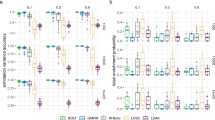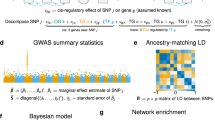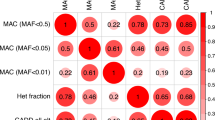Abstract
Patterns of gene expression in the central nervous system are highly variable and heritable. This genetic variation among normal individuals leads to considerable structural, functional and behavioral differences. We devised a general approach to dissect genetic networks systematically across biological scale, from base pairs to behavior, using a reference population of recombinant inbred strains. We profiled gene expression using Affymetrix oligonucleotide arrays in the BXD recombinant inbred strains, for which we have extensive SNP and haplotype data. We integrated a complementary database comprising 25 years of legacy phenotypic data on these strains. Covariance among gene expression and pharmacological and behavioral traits is often highly significant, corroborates known functional relations and is often generated by common quantitative trait loci. We found that a small number of major-effect quantitative trait loci jointly modulated large sets of transcripts and classical neural phenotypes in patterns specific to each tissue. We developed new analytic and graph theoretical approaches to study shared genetic modulation of networks of traits using gene sets involved in neural synapse function as an example. We built these tools into an open web resource called WebQTL that can be used to test a broad array of hypotheses.
This is a preview of subscription content, access via your institution
Access options
Subscribe to this journal
Receive 12 print issues and online access
$209.00 per year
only $17.42 per issue
Buy this article
- Purchase on SpringerLink
- Instant access to full article PDF
Prices may be subject to local taxes which are calculated during checkout






Similar content being viewed by others
References
Cowles, C.R., Hirschorn, J.N., Altshuler, D. & Lander, E.S. Detection of regulatory variation in mouse genes. Nat. Genet. 32, 432–437 (2002).
Jansen, R. & Nap, J.P. Genetical genomics: the added value from segregation. Trends Genet. 17, 388–391 (2001).
Brem, R., Yvert, G., Clinton, R. & Kruglyak, L. Genetic dissection of transcriptional regulation in budding yeast. Science 296, 725–755 (2002).
Bading, H., Ginty, D.D. & Greenberg, M.E. Regulation of gene expression in hippocampal neurons by distinct calcium signaling pathways. Science 260, 181–186 (1993).
Paigen, K. & Eppig, J. A mouse phenome project. Mamm. Genome 111, 715–717 (2000).
Threadgill, D.W., Hunter, K.W. & Williams, R.W. Genetic dissection of complex and quantitative traits: from fantasy to reality via a community effort. Mamm. Genome 13, 175–178 (2002).
Peirce, J.L. et al. A new set of BXD recombinant inbred lines from advanced intercross populations in mice. BMC Genet. 5, 7 (2004).
Li, X. et al. High-resolution genetic mapping of the saccharin preference locus (Sac) and the putative sweet taste receptor (T1R1) gene (Gpr70) to mouse distal Chromosome 4. Mamm. Genome 12, 13–16 (2001).
Mogil, J.S. et al. The melanocortin-1 receptor gene mediates female-specific mechanisms of analgesia in mice and humans. Proc. Natl. Acad. Sci. USA 100, 4867–4872 (2003).
Shirley, R.L. et al. Mpdz is a quantitative trait gene for drug withdrawal seizures. Nat. Neurosci. 7, 699–700 (2004).
Taylor, B.A. et al. Genotyping new BXD recombinant inbred mouse strains and comparison of BXD and consensus maps. Mamm. Genome 10, 335–348 (1999).
Flint, J. Analysis of quantitative trait loci that influence animal behavior. J. Neurobiol. 54, 46–77 (2003).
Schadt, E.E. et al. Genetics of gene expression surveyed in maize, mouse and man. Nature 422, 297–302 (2003).
Bystrykh, L. et al. Uncovering regulatory pathways that affect hematopoietic stem cell function using 'genetical genomics'. Nat. Genet. advance online publication, 13 February 2005 (10.1038/ng1497).
Belknap, J.K. Effect of within-strain sample size on QTL detection and mapping using recombinant inbred mouse strains. Behav. Genet. 28, 29–38 (1998).
Wang, J., Williams, R.W. & Manly, K.F. WebQTL: Web-based complex trait analysis. Neuroinformatics 1, 299–308 (2003).
Rikke, B.A. & Johnson, T.E. Towards the cloning of genes underlying murine QTLs. Mamm. Genome 9, 963–968 (1998).
Visscher, P.M. Speed congenics: accelerated genome recovery using genetic markers. Genet. Res. 74, 81–85 (1999).
Benjamini, Y. & Hochberg, Y. Controlling the false discovery rate: a practical and powerful approach to multiple testing. J. R. Stat. Soc. B 57, 289–300 (1995).
Manly, K.F., Nettleton, D. & Hwang, J.T. Genomics, prior probability, and statistical tests of multiple hypotheses. Genome Res. 14, 997–1001 (2004).
Storey, J.D., Taylor, J.E. & Siegmund, D. Strong control, conservative point estimation, and simultaneous conservative consistency of false discovery rates: a unified approach. J. R. Stat. Soc. B 66, 187–205 (2004).
Ashburner, M. et al. Gene ontology: tool for the unification of biology. The Gene Ontology Consortium. Nat. Genet. 25, 25–29 (2000).
Zhang, B., Schmoyer, D., Kirov, S. & Snoddy, J. GOTree Machine (GOTM): a web-based platform for interpreting interesting sets of genes using Gene Ontology hierarchies. BMC Bioinformatics 5, 16 (2004).
Chesler, E.J., Lu, L., Wang, J., Williams, R.W. & Manly, K.F. WebQTL: rapid exploratory analysis of gene expression and genetic networks for brain and behavior. Nat. Neurosci. 7, 485–486 (2004).
Chesler, E.J. et al. Genetic correlates of gene expression in recombinant inbred strains: a relational model system to explore neurobehavioral phenotypes. Neuroinformatics 1, 343–357 (2003).
Churchill, G.A. et al. The Collaborative Cross, a community resource for the genetic analysis of complex traits. Nat. Genet. 36, 1133–1137 (2004).
Lu, L., Airey, D.C. & Williams, R.W. Complex trait analysis of the hippocampus: mapping and biometric analysis of two novel gene loci with specific effects on hippocampal structure in mice. J. Neurosci. 21, 3503–3514 (2001).
Peirce, J.L., Chesler, E.J., Williams, R.W. & Lu, L. Genetic architecture of the mouse hippocampus: identification of gene loci with selective regional effects. Genes Brain Behav. 2, 238–252 (2003).
Jones, B.C. et al. Quantitative genetic analysis of ventral midbrain and liver iron in BXD recombinant inbred mice. Nutr. Neurosci. 6, 369–377 (2003).
Cunningham, C.L. Localization of genes influencing ethanol-induced conditioned place preference and locomotor activity in BXD recombinant inbred mice. Psychopharmacology 120, 28–24 (1995).
Risinger, F.O. & Cunningham, C.L. Ethanol-induced conditioned taste aversion in BXD recombinant inbred mice. Alcohol. Clin. Exp. Res. 22, 1234–1244 (1998).
Crabbe, J.C., Kosobud, A., Young, E.R. & Janowsky, J.S. Polygenic and single-gene determination of responses to ethanol in BXD/Ty recombinant inbred mouse strains. Neurobehav. Toxicol. Teratol. 5, 181–187 (1983).
Phillips, T.J., Crabbe, J.C., Metten, P. & Belknap, J.K. Localization of genes affecting alcohol drinking in mice. Alcohol. Clin. Exp. Res. 18, 931–941 (1994).
Phillips, T.J., Huson, M., Gwiazdon, C., Burkhart-Kasch, S. & Shen, E.H. Effects of acute and repeated ethanol exposures on the locomotor activity of BXD recombinant inbred mice. Alcohol. Clin. Exp. Res. 19, 269–278 (1995).
Hitzemann, R. et al. Dopamine D2 receptor binding, Drd2 expression and the number of dopamine neurons in the BXD recombinant inbred series: genetic relationships to alcohol and other drug associated phenotypes. Alcohol. Clin. Exp. Res. 27, 1–11 (2003).
Storey, J.D. & Tibshirani, R. Statistical significance for genomewide studies. Proc. Natl. Acad. Sci. USA 100, 9440–9445 (2003).
Blichenberg, A. et al. Identification of a cis-acting dendritic targeting element in MAP2 mRNAs. J. Neurosci. 19, 8818–8829 (1999).
Jeong, H., Tombor, B., Albert, R., Oltvai, Z.N. & Barabási, A.-L. The large scale organization of metabolic networks. Nature 407, 651–653 (2000).
Baldwin, N.E. et al. Computational, integrative and comparative methods for the elucidation of genetic co-expression networks. J. Biomed. Biotechnol. (in the press).
Bartoli, M. et al. Down-regulation of striatin, a neuronal calmodulin-binding protein, impairs rat locomotor activity. J. Neurobiol. 40, 234–243 (1999).
Becamel, C. et al. Synaptic multiprotein complexes associated with 5-HT(2C) receptors: a proteomic approach. EMBO J. 21, 2332–2342 (2002).
Klose, J. et al. Genetic analysis of the mouse brain proteome. Nat. Genet. 30, 385–393 (2002).
Chesler, E.J. & Williams, R.W. Brain gene expression: genomics and genetics. Int. Rev. Neurobiol. 60, 59–95 (2004).
Yalcin, B. et al. Genetic dissection of a behavioral quantitative trait locus shows that Rgs2 modulates anxiety in mice. Nat. Genet. 36, 1197–1202 (2004).
Williams, R.W., Gu, J., Qi, S. & Lu, L. The genetic structure of recombinant inbred mice: high-resolution consensus maps for complex trait analysis. Genome Biol. 2, RESEARCH0046 (2002).
Irizarry, R.A. et al. Summaries of Affymetrix GeneChip probe level data. Nucleic Acids Res. 31, e15 (2003).
Churchill, G.A. & Doerge, R.W. Empirical threshold values for quantitative trait mapping. Genetics 138, 963–971 (1994).
Visscher, P.M., Thomopson, R. & Haley, C.S. Confidence intervals in QTL mapping by bootstrapping. Genetics 143, 1013–1020 (1996).
Hutson, A.D. Bootstrap smoothing strategies based on uniform spacings with practical applications. Technical Report. (Division of Biostatistics, University at Buffalo, Buffalo, New York, 2002).
Broman, K., Wu, H., Sen, S. & Churchill, G.A. R/qtl: QTL mapping in experimental crosses. Bioinformatics, 19, 889–890 (2003).
Acknowledgements
We thank T. Sutter and the Feinstone Center for array support, J. Hogenesch and R. Edwards for helping to map probe sets using BLAT and J. Crabbe and J. Belknap for assistance in updating and compiling the many traits they have contributed to the Published Phenotypes database. Most arrays were processed at Genome Explorations Inc. by D. Patel. The authors acknowledge support of a Human Brain Project funded by the National Institute of Mental Health, the National Institute of Drug Abuse and the National Science Foundation, and an Integrative Neuroscience Initiative on Alcoholism grant from the National Institute of Alcohol Abuse and Addiction. Array costs were covered by the Dunavant Chair of Excellence, University of Tennessee Health Science Center, Department of Pediatrics. Additional support was provided by the National Institute of Aging, the National Science Foundation, Veterans Affairs and the Office of Naval Research.
Author information
Authors and Affiliations
Corresponding author
Ethics declarations
Competing interests
The authors declare no competing financial interests.
Supplementary information
Supplementary Table 1
Genetic variation and fold range of strain means for transcript abundance. (DOC 241 kb)
Supplementary Table 2
Locations of best cis- and trans-QTLs based on genetic variance >30% and FDR (q-value) < 25%. (DOC 244 kb)
Supplementary Table 3
Location and SNP density by location in the major trans-QTL bands. (DOC 44 kb)
Supplementary Table 4
Tissue specificity and number of single nucleotide polymorphisms (SNPs) by location in cis-QTLs. (DOC 209 kb)
Rights and permissions
About this article
Cite this article
Chesler, E., Lu, L., Shou, S. et al. Complex trait analysis of gene expression uncovers polygenic and pleiotropic networks that modulate nervous system function. Nat Genet 37, 233–242 (2005). https://doi.org/10.1038/ng1518
Received:
Accepted:
Published:
Issue Date:
DOI: https://doi.org/10.1038/ng1518



